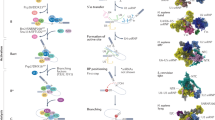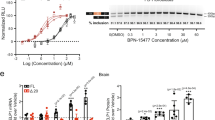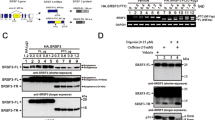Abstract
The transcription factor E2F1 has a key function during S phase progression and apoptosis. It has been well-demonstrated that the apoptotic function of E2F1 involves its ability to transactivate pro-apoptotic target genes. Alternative splicing of pre-mRNAs also has an important function in the regulation of apoptosis. In this study, we identify the splicing factor SC35, a member of the Ser-Rich Arg (SR) proteins family, as a new transcriptional target of E2F1. We demonstrate that E2F1 requires SC35 to switch the alternative splicing profile of various apoptotic genes such as c-flip, caspases-8 and -9 and Bcl-x, towards the expression of pro-apoptotic splice variants. Finally, we provide evidence that E2F1 upregulates SC35 in response to DNA-damaging agents and show that SC35 is required for apoptosis in response to these drugs. Taken together, these results demonstrate that E2F1 controls pre-mRNA processing events to induce apoptosis and identify the SC35 SR protein as a key direct E2F1-target in this setting.
Similar content being viewed by others
Log in or create a free account to read this content
Gain free access to this article, as well as selected content from this journal and more on nature.com
or
Abbreviations
- CAT:
-
chloramphenicol acetyl transferase
- ChIP:
-
chromatin immunoprecipitation
- Fas L:
-
Fas ligand
- FLIP:
-
FLICE inhibitory protein
- MEF:
-
murine embryonic fibroblast
- p54nrb:
-
p54 nuclear RNA-binding protein
- PSF:
-
polypyrimidine tract-binding protein-associated splicing factor
- RRM:
-
RNA recognition motif
- siRNA:
-
small interfering RNA
- SR:
-
ser-rich
- TRAIL:
-
tumor necrosis factor-related apoptosis-inducing ligand
References
Smith CW, Valcarcel J . Alternative pre-mRNA splicing: the logic of combinatorial control. Trends Biochem Sci 2000; 25: 381–388.
Sanford JR, Ellis J, Caceres JF . Multiple roles of arginine/serine-rich splicing factors in RNA processing. Biochem Soc Trans 2005; 33: 443–446.
Spector DL, Fu XD, Maniatis T . Associations between distinct pre-mRNA splicing components and the cell nucleus. EMBO J 1991; 10: 3467–3481.
Sanford JR, Longman D, Caceres JF . Multiple roles of the SR protein family in splicing regulation. Prog Mol Subcell Biol 2003; 31: 33–58.
Schwerk C, Schulze-Osthoff K . Regulation of apoptosis by alternative pre-mRNA splicing. Mol Cell 2005; 19: 1–13.
Utz PJ, Hottelet M, van Venrooij WJ, Anderson P . Association of phosphorylated serine/arginine (SR) splicing factors with the U1-small ribonucleoprotein (snRNP) autoantigen complex accompanies apoptotic cell death. J Exp Med 1998; 187: 547–560.
Jiang ZH, Zhang WJ, Rao Y, Wu JY . Regulation of Ich-1 pre-mRNA alternative splicing and apoptosis by mammalian splicing factors. Proc Natl Acad Sci USA 1998; 95: 9155–9160.
Li X, Wang J, Manley JL . Loss of splicing factor ASF/SF2 induces G2 cell cycle arrest and apoptosis, but inhibits internucleosomal DNA fragmentation. Genes Dev 2005; 19: 2705–2714.
Wang J, Takagaki Y, Manley JL . Targeted disruption of an essential vertebrate gene: ASF/SF2 is required for cell viability. Genes Dev 1996; 10: 2588–2599.
DeGregori J, Johnson DG . Distinct and overlapping roles for E2F family members in transcription, proliferation and apoptosis. Curr Mol Med 2006; 6: 739–748.
Salon C, Eymin B, Micheau O, Chaperot L, Plumas J, Brambilla C et al. E2F1 induces apoptosis and sensitizes human lung adenocarcinoma cells to death-receptor-mediated apoptosis through specific downregulation of c-FLIP(short). Cell Death Differ 2006; 13: 260–272.
Sureau A, Soret J, Vellard M, Crochet J, Perbal B . The PR264/c-myb connection: expression of a splicing factor modulated by a nuclear protooncogene. Proc Natl Acad Sci USA 1992; 89: 11683–11687.
Reichert M, Saur D, Hamacher R, Schmid RM, Schneider G . Phosphoinositide-3-kinase signaling controls S-phase kinase-associated protein 2 transcription via E2F1 in pancreatic ductal adenocarcinoma cells. Cancer Res 2007; 67: 4149–4156.
Tschopp J, Irmler M, Thome M . Inhibition of fas death signals by FLIPs. Curr Opin Immunol 1998; 10: 552–558.
Eckhart L, Henry M, Santos-Beneit AM, Schmitz I, Krueger A, Fischer H et al. Alternative splicing of caspase-8 mRNA during differentiation of human leukocytes. Biochem Biophys Res Commun 2001; 289: 777–781.
Himeji D, Horiuchi T, Tsukamoto H, Hayashi K, Watanabe T, Harada M . Characterization of caspase-8L: a novel isoform of caspase-8 that behaves as an inhibitor of the caspase cascade. Blood 2002; 99: 4070–4078.
Chalfant CE, Rathman K, Pinkerman RL, Wood RE, Obeid LM, Ogretmen B et al. De novo ceramide regulates the alternative splicing of caspase 9 and Bcl-x in A549 lung adenocarcinoma cells. Dependence on protein phosphatase-1. J Biol Chem 2002; 277: 12587–12595.
Massiello A, Chalfant CE . SRp30a (ASF/SF2) regulates the alternative splicing of caspase-9 pre-mRNA and is required for ceramide-responsiveness. J Lipid Res 2006; 47: 892–897.
Nahle Z, Polakoff J, Davuluri RV, McCurrach ME, Jacobson MD, Narita M et al. Direct coupling of the cell cycle and cell death machinery by E2F. Nat Cell Biol 2002; 4: 859–864.
Boise LH, Gonzalez-Garcia M, Postema CE, Ding L, Lindsten T, Turka LA et al. Bcl-x, a bcl-2-related gene that functions as a dominant regulator of apoptotic cell death. Cell 1993; 74: 597–608.
Stevens C, Smith L, La Thangue NB . Chk2 activates E2F-1 in response to DNA damage. Nat Cell Biol 2003; 5: 401–409.
Wang C, Chen L, Hou X, Li Z, Kabra N, Ma Y et al. Interactions between E2F1 and SirT1 regulate apoptotic response to DNA damage. Nat Cell Biol 2006; 8: 1025–1031.
Ren B, Cam H, Takahashi Y, Volkert T, Terragni J, Young RA et al. E2F integrates cell cycle progression with DNA repair, replication, and G(2)/M checkpoints. Genes Dev 2002; 16: 245–256.
Muller H, Bracken AP, Vernell R, Moroni MC, Christians F, Grassilli E et al. E2Fs regulate the expression of genes involved in differentiation, development, proliferation, and apoptosis. Genes Dev 2001; 15: 267–285.
Kornblihtt AR . Promoter usage and alternative splicing. Curr Opin Cell Biol 2005; 17: 262–268.
Cramer P, Pesce CG, Baralle FE, Kornblihtt AR . Functional association between promoter structure and transcript alternative splicing. Proc Natl Acad Sci USA 1997; 94: 11456–11460.
Cramer P, Caceres JF, Cazalla D, Kadener S, Muro AF, Baralle FE et al. Coupling of transcription with alternative splicing: RNA pol II promoters modulate SF2/ASF and 9G8 effects on an exonic splicing enhancer. Mol Cell 1999; 4: 251–258.
Auboeuf D, Dowhan DH, Dutertre M, Martin N, Berget SM, O'Malley BW . A subset of nuclear receptor coregulators act as coupling proteins during synthesis and maturation of RNA transcripts. Mol Cell Biol 2005; 25: 5307–5316.
Auboeuf D, Dowhan DH, Kang YK, Larkin K, Lee JW, Berget SM et al. Differential recruitment of nuclear receptor coactivators may determine alternative RNA splice site choice in target genes. Proc Natl Acad Sci USA 2004; 101: 2270–2274.
Auboeuf D, Dowhan DH, Li X, Larkin K, Ko L, Berget SM et al. CoAA, a nuclear receptor coactivator protein at the interface of transcriptional coactivation and RNA splicing. Mol Cell Biol 2004; 24: 442–453.
Chansky HA, Hu M, Hickstein DD, Yang L . Oncogenic TLS/ERG and EWS/Fli-1 fusion proteins inhibit RNA splicing mediated by YB-1 protein. Cancer Res 2001; 61: 3586–3590.
Guillouf C, Gallais I, Moreau-Gachelin F . Spi-1/PU.1 oncoprotein affects splicing decisions in a promoter binding-dependent manner. J Biol Chem 2006; 281: 19145–19155.
Kamachi M, Le TM, Kim SJ, Geiger ME, Anderson P, Utz PJ . Human autoimmune sera as molecular probes for the identification of an autoantigen kinase signaling pathway. J Exp Med 2002; 196: 1213–1225.
Mercatante D, Kole R . Modification of alternative splicing pathways as a potential approach to chemotherapy. Pharmacol Ther 2000; 85: 237–243.
Hayes GM, Carrigan PE, Beck AM, Miller LJ . Targeting the RNA splicing machinery as a novel treatment strategy for pancreatic carcinoma. Cancer Res 2006; 66: 3819–3827.
Cardoso RS, Espanhol AR, Passos GA, Sakamoto-Hojo ET . Differential gene expression in gamma-irradiated BALB/3T3 fibroblasts under the influence of 3-aminobenzamide, an inhibitior of parp enzyme. Mutat Res 2002; 508: 33–40.
Filippov V, Filippova M, Duerksen-Hughes PJ . The early response to DNA damage can lead to activation of alternative splicing activity resulting in CD44 splice pattern changes. Cancer Res 2007; 67: 7621–7630.
Johnson DG, Degregori J . Putting the oncogenic and tumor suppressive activities of E2F into context. Curr Mol Med 2006; 6: 731–738.
Eymin B, Gazzeri S, Brambilla C, Brambilla E . Distinct pattern of E2F1 expression in human lung tumours: E2F1 is upregulated in small cell lung carcinoma. Oncogene 2001; 20: 1678–1687.
Fischer DC, Noack K, Runnebaum IB, Watermann DO, Kieback DG, Stamm S et al. Expression of splicing factors in human ovarian cancer. Oncol Rep 2004; 11: 1085–1090.
Karni R, de Stanchina E, Lowe SW, Sinha R, Mu D, Krainer AR . The gene encoding the splicing factor SF2/ASF is a proto-oncogene. Nat Struct Mol Biol 2007; 14: 185–193.
Salon C, Merdzhanova G, Brambilla C, Brambilla E, Gazzeri S, Eymin B . E2F-1, Skp2 and cyclin E oncoproteins are upregulated and directly correlated in high-grade neuroendocrine lung tumors. Oncogene 2007; 26: 6927–6936.
Acknowledgements
We thank Patricia Betton, Pascal Perron and Celine Lampreia for technical assistance. We thank Johann Soret (IGM, Montpellier) for the pECE-SC35HA and Alain Sureau (CGM, Gif sur Yvette) for pR264-CAT plasmids. We thank Didier Auboeuf, Martin Dutertre, Saadi Khochbin, Johann Soret and Jamal Tazi for encouraging discussions and critical reading of this paper. We thank Mary Callanan (INSERM U823) for help with editing. This work was supported by grants from the region Rhône Alpes (Thématique Prioritaire Cancer and Canceropole 2003: Oncocell, Epimed and INACancer), by the Ligue contre le Cancer (Comité de Savoie), by the Ligue Nationale contre le Cancer (Equipe Labellisée), by INCa (PNES, Programme National d'Excellence Spécialisé 2005) and by the Conseil Scientifique National d'AGIR à dom. Arnaud van den Broeck was supported by a fellowship from the French Research Ministry. Galina Merdzhanova was supported by fellowships from the French Research Ministry and the Fondation pour la Recherche Medicale (FRM). Valerie Edmond was supported by a grant from the Conseil Scientifique National d'AGIR à dom. Sandrine De Seranno was supported by a grant from INCa.
Author information
Authors and Affiliations
Corresponding author
Additional information
Edited by B Dynlacht
Supplementary Information accompanies the paper on Cell Death and Differentiation website (http://www.nature.com/cdd)
Supplementary information
Rights and permissions
About this article
Cite this article
Merdzhanova, G., Edmond, V., De Seranno, S. et al. E2F1 controls alternative splicing pattern of genes involved in apoptosis through upregulation of the splicing factor SC35. Cell Death Differ 15, 1815–1823 (2008). https://doi.org/10.1038/cdd.2008.135
Received:
Revised:
Accepted:
Published:
Issue date:
DOI: https://doi.org/10.1038/cdd.2008.135
Keywords
This article is cited by
-
Aberrant Bcl-x splicing in cancer: from molecular mechanism to therapeutic modulation
Journal of Experimental & Clinical Cancer Research (2021)
-
Splicing factor proline- and glutamine-rich (SFPQ) protein regulates platinum response in ovarian cancer-modulating SRSF2 activity
Oncogene (2020)
-
Modulation of SRSF2 expression reverses the exhaustion of TILs via the epigenetic regulation of immune checkpoint molecules
Cellular and Molecular Life Sciences (2020)
-
BCL-2 family isoforms in apoptosis and cancer
Cell Death & Disease (2019)
-
VEGF165b, a splice variant of VEGF-A, promotes lung tumor progression and escape from anti-angiogenic therapies through a β1 integrin/VEGFR autocrine loop
Oncogene (2019)



